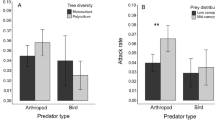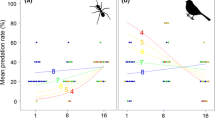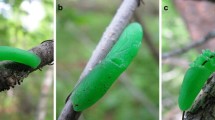Abstract
Tree diversity promotes predator abundance and diversity, but evidence linking these effects to increased predation pressure on herbivores remains limited. In addition, tree diversity effects on predators can vary temporally as a function of environmental variation, or due to contrasting responses by different predator types. In a multi-year study, we assessed temporal variation in tree diversity effects on bird community abundance, diversity, and predation rates as a whole and by functional group based on feeding guild (omnivores vs. insectivores) and migratory status (migrant vs. resident). To this end, we conducted bird point counts in tree monocultures and polycultures and assessed attacks on clay caterpillars four times over a 2-year period in a tree diversity experiment in Yucatan, Mexico. Tree diversity effects on the bird community varied across surveys, with positive effects on bird abundance and diversity in most but not all surveys. Tree diversity had stronger and more consistent effects on omnivorous and resident birds than on insectivorous and migratory species. Tree diversity effects on attack rates also varied temporally but patterns did not align with variation in bird abundance or diversity. Thus, while we found support for predicted increases in bird abundance, diversity, and predation pressure with tree diversity, these responses exhibited substantial variation over time and the former two were uncoupled from patterns of predation pressure, as well as contingent on bird functional traits. These results underscore the need for long-term studies measuring responses by different predator functional groups to better understand tree diversity effects on top-down control.





Similar content being viewed by others

Data availability
All data generated or analysed during this study will be included in the supplementary information files and/or stored in a public repository.
References
Abdala-Roberts L, Mooney KA, Quijano-Medina T, Campos-Navarrete MJ, González-Moreno A, Parra-Tabla V (2015) Comparison of tree genotypic diversity and species diversity effects on different guilds of insect herbivores. Oikos 124:1527–1535
Ampoorter E, Barbaro L, Jactel H, Baeten L, Boberg J, Carnol M, Castagneyrol B, Charbonnier Y, Dawud SM, Deconchat M (2020) Tree diversity is key for promoting the diversity and abundance of forest-associated taxa in Europe. Oikos 129:133–146
Berlanga HA, de Silva HG, Vargas Canales VM, Rodríguez Contreras V, Sánchez González LA, Ortega Álvarez R, Calderón-Parra R (2015) Aves de México: lista actualizada de especies y nombres comunes 2015. Comisión Nacional para el Conocimiento y Uso de la Biodiversidad (CONABIO)
Bertness MD, Callaway R (1994) Positive interactions in communities. Trends Ecol Evol 9:191–193
Betancurt-Grisales JF, Vargas-Daza AM, Castaño-Villa GJ, Ospina-Bautista F (2021) Bird functional diversity in restored and secondary forests of the Colombian Andes. Restor Ecol 29:e13315
Betts MG, Phalan B, Frey SJ, Rousseau JS, Yang Z (2018) Old-growth forests buffer climate-sensitive bird populations from warming. Divers Distrib 24:439–447
Bommarco R, Banks JE (2003) Scale as modifier in vegetation diversity experiments: effects on herbivores and predators. Oikos, 440–448
Both C, Van Turnhout CA, Bijlsma RG, Siepel H, Van Strien AJ, Foppen RP (2010) Avian population consequences of climate change are most severe for long-distance migrants in seasonal habitats. Proc Royal Soc B Biol Sci 277:1259–1266
Cardinale BJ, Srivastava DS, Emmett Duffy J, Wright JP, Downing AL, Sankaran M, Jouseau C (2006) Effects of biodiversity on the functioning of trophic groups and ecosystems. Nature 443:989–992
Cardinale BJ, Matulich KL, Hooper DU, Byrnes JE, Duffy E, Gamfeldt L, Balvanera P, O’connor MI, Gonzalez A (2011) The functional role of producer diversity in ecosystems. Am J Bot 98:572–592
Castaño-Villa GJ, Estevez JV, Fontúrbel FE (2014) The role of native forest plantations in the conservation of Neotropical birds: the case of the Andean alder. J Nat Conserv 22:547–551
Chesser R, Burns K, Cicero C, Dunn J, Kratter A, Lovette I, Rasmussen P, Remsen Jr J, Stotz D, Winger B (2018) Check-list of North American birds. Chicago (IL): American Ornithological Society. http://checklist.aou.org/taxa. Accessed 19 Mar 2019
Cohen JM, Fink D, Zuckerberg B (2020) Avian responses to extreme weather across functional traits and temporal scales. Glob Change Biol 26:4240–4250
Forrester DI (2014) The spatial and temporal dynamics of species interactions in mixed-species forests: from pattern to process. For Ecol Manage 312:282–292
Gessner MO, Hines J (2012) Stress as a modifier of biodiversity effects on ecosystem processes? J Anim Ecol 81:1143–1145
Gower JC (1971) A general coefficient of similarity and some of its properties. Biometrics 27:857–871
Greenberg R (1995) Insectivorous migratory birds in tropical ecosystems: the breeding currency hypothesis. J Avian Biol 26:260–264
Hackett SJ, Kimball RT, Reddy S, Bowie RC, Braun EL, Braun MJ, Chojnowski JL, Cox WA, Han K-L, Harshman J (2008) A phylogenomic study of birds reveals their evolutionary history. Science 320:1763–1768
Haddad NM, Crutsinger GM, Gross K, Haarstad J, Knops JM, Tilman D (2009) Plant species loss decreases arthropod diversity and shifts trophic structure. Ecol Lett 12:1029–1039
Harvey CA, Medina A, Sánchez DM, Vílchez S, Hernández B, Saenz JC, Maes JM, Casanoves F, Sinclair FL (2006) Patterns of animal diversity in different forms of tree cover in agricultural landscapes. Ecol Appl 16:1986–1999
Hooper DU, Chapin FS III, Ewel JJ, Hector A, Inchausti P, Lavorel S, Lawton JH, Lodge D, Loreau M, Naeem S (2005) Effects of biodiversity on ecosystem functioning: a consensus of current knowledge. Ecol Monogr 75:3–35
Huang Y, Zhao Y, Li S, von Gadow K (2015) The effects of habitat area, vegetation structure and insect richness on breeding bird populations in Beijing urban parks. Urban for Urban Green 14:1027–1039
Interian-Aguiñaga J, Parra-Tabla V, Abdala-Roberts L (2022) Effects of topical tree diversity and prey spatial distribution on predation by birds and arthropods. Arthropod-Plant Interact 16:449–457
Jankowski JE, Merkord CL, Rios WF, Cabrera KG, Revilla NS, Silman MR (2013) The relationship of tropical bird communities to tree species composition and vegetation structure along an Andean elevational gradient. J Biogeogr 40:950–962
Jetz W, Thomas GH, Joy JB, Hartmann K, Mooers AO (2012) The global diversity of birds in space and time. Nature 491:444–448
Jucker T, Coomes DA (2012) Comment on “Plant species richness and ecosystem multifunctionality in global drylands.” Science 337:155–155
Kuznetsova A, Brockhoff PB, Christensen RHB (2017) LmerTest package: tests in linear mixed effects models. J Stat Softw 82:1–26
Langellotto GA, Denno RF (2004) Responses of invertebrate natural enemies to complex-structured habitats: a meta-analytical synthesis. Oecologia 139:1–10
Lenth RV (2016) Least-squares means: the R package lsmeans. J Stat Softw 69:1–33
Letourneau DK, Armbrecht I, Rivera BS, Lerma JM, Carmona EJ, Daza MC, Escobar S, Galindo V, Gutiérrez C, López SD (2011) Does plant diversity benefit agroecosystems? A synthetic review. Ecol Appl 21:9–21
Maas B, Karp DS, Bumrungsri S, Darras K, Gonthier D, Huang JCC, Lindell CA, Maine JJ, Mestre L, Michel NL (2016) Bird and bat predation services in tropical forests and agroforestry landscapes. Biol Rev 91:1081–1101
May-Uc Y, Nell CS, Parra-Tabla V, Navarro J, Abdala-Roberts L (2020) Tree diversity effects through a temporal lens: Implications for the abundance, diversity and stability of foraging birds. J Anim Ecol 89:1775–1787
McGinn KA, Zuckerberg B, Pauli JN, Zulla CJ, Berigan WJ, Wilkinson ZA, Barry JM, Keane JJ, Gutiérrez R, Peery MZ (2023) Older forests function as energetic and demographic refugia for a climate-sensitive species. Oecologia 202:831–844
Molleman F, Remmel T, Sam K (2016) Phenology of predation on insects in a tropical forest: temporal variation in attack rate on dummy caterpillars. Biotropica 48:229–236
Mooney KA, Gruner DS, Barber NA, Van Bael SA, Philpott SM, Greenberg R (2010) Interactions among predators and the cascading effects of vertebrate insectivores on arthropod communities and plants. Proc Natl Acad Sci 107:7335–7340
Muiruri EW, Rainio K, Koricheva J (2016) Do birds see the forest for the trees? Scale-dependent effects of tree diversity on avian predation of artificial larvae. Oecologia 180:619–630
Nell CS, Abdala-Roberts L, Parra-Tabla V, Mooney KA (2018) Tropical tree diversity mediates foraging and predatory effects of insectivorous birds. Proc Royal Soc B Biol Sci 285:20181842
Piovia-Scott J, Yang LH, Wright AN (2017) Temporal variation in trophic cascades. Annu Rev Ecol Evol Syst 48:281–300
Root RB (1973) Organization of a plant-arthropod association in simple and diverse habitats: the fauna of collards (Brassica oleracea). Ecol Monogr 43:95–124
Schnabel F, Beugnon R, Yang B, Richter R, Eisenhauer N, Huang Y, Liu X, Wirth C, Cesarz S, Fichtner A (2023) Tree diversity increases forest temperature buffering. bioRxiv, 2023.09. 11.556807.
Singer MS, Farkas TE, Skorik CM, Mooney KA (2012) Tritrophic interactions at a community level: effects of host plant species quality on bird predation of caterpillars. Am Nat 179:363–374
Staab M, Schuldt A (2020) The influence of tree diversity on natural enemies—a review of the “enemies” hypothesis in forests. Curr for Rep 6:243–259
Stemmelen A, Jactel H, Brockerhoff E, Castagneyrol B (2022) Meta-analysis of tree diversity effects on the abundance, diversity and activity of herbivores’ enemies. Basic Appl Ecol 58:130–138
Tilman D, Reich PB, Knops J, Wedin D, Mielke T, Lehman C (2001) Diversity and productivity in a long-term grassland experiment. Science 294:843–845
Van Bael SA, Philpott SM, Greenberg R, Bichier P, Barber NA, Mooney KA, Gruner DS (2008) Birds as predators in tropical agroforestry systems. Ecology 89:928–934
Whelan CJ, Wenny DG, Marquis RJ (2008) Ecosystem services provided by birds. Ann NY Acad Sci 1134:25–60
Wilman H, Belmaker J, Simpson J, de la Rosa C, Rivadeneira MM, Jetz W (2014) EltonTraits 1.0: species-level foraging attributes of the world’s birds and mammals: ecological archives E095–178. Ecology 95:2027–2027
Yang B, Li B, He Y, Zhang L, Bruelheide H, Schuldt A (2018) Tree diversity has contrasting effects on predation rates by birds and arthropods on three broadleaved, subtropical tree species. Ecol Res 33:205–212
Zhang J, Bruelheide H, Chen X, Eichenberg D, Kröber W, Xu X, Xu L, Schuldt A (2017) Tree diversity promotes generalist herbivore community patterns in a young subtropical forest experiment. Oecologia 183:455–467
Zvereva EL, Kozlov MV (2022) Predation risk estimated on live and artificial insect prey follows different patterns. Ecology 104:e3943
Funding
This research was financially supported by CONACYT (CB-2015-01-250925) awarded to L.A.R. and V.P.T. CVG was supported by a postdoctoral fellowship from the Xunta de Galicia-GAIN/Fulbright (IN606B 2021/004). The authors thank the INIFAP staff at the Uxmal Experimental Site for logistic support. We thank Y. May, A. Súarez, D. Pérez, E. Alcocer, C. Padilla, R. Avilés, W. Adrián, Y. Chontal, C. Chavez Chablé and L. Vázquez May for field assistance.
Author information
Authors and Affiliations
Contributions
Formulated the idea of the manuscript and designed the experiment: LAR. Performed the experiment: MRH, EVG, BPN, TQM. Analysed the data: CVG. Wrote the first draft of the manuscript: CVG. Contributed critically to the writing: LAR and KAM. All co-authors contributed with editions to previous versions of the manuscript and all authors gave final approval for publication and agree to be held accountable for the work performed therein.
Corresponding author
Ethics declarations
Conflict of interest
The authors report no conflicts of interest in this work and have nothing to disclose.
Additional information
Communicated by Francisco E Fonturbel.
Supplementary Information
Below is the link to the electronic supplementary material.
Rights and permissions
Springer Nature or its licensor (e.g. a society or other partner) holds exclusive rights to this article under a publishing agreement with the author(s) or other rightsholder(s); author self-archiving of the accepted manuscript version of this article is solely governed by the terms of such publishing agreement and applicable law.
About this article
Cite this article
Vázquez-González, C., Villa-Galaviz, E., Reyes-Hernández, M. et al. Temporal variation in tree diversity effects on birds and its implications for top-down control of insect herbivores in a tropical system. Oecologia 204, 603–612 (2024). https://doi.org/10.1007/s00442-024-05514-1
Received:
Accepted:
Published:
Issue Date:
DOI: https://doi.org/10.1007/s00442-024-05514-1



